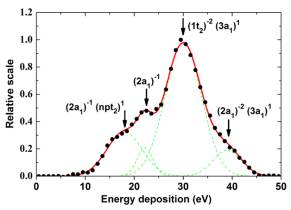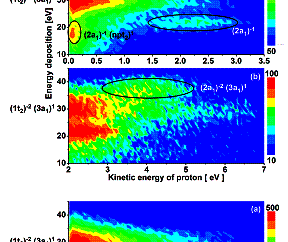The formation of protons from dissociation of methane induced by 54 eV electron impact was investigated by researchers at Institute of Modern Physics, Chinese Academy of Sciences (IMP) and the collaborators in Max Planck Institute for Nuclear Physics, Germany (MPIK).
It is found that the (2a1)-1(npt2)1, (2a1)-1, (1t2)-2(3a1)1 and (2a1)-2(3a1)1 states of the intermediate CH4+ make major contributions to the formation of the protons at this incident energy range(as shown in fig 1). The kinetic energy distributions of the emitted protons show strong dependence on the intermediate states, which indicates that they decay through different mechanisms(as shown in fig 2).
The advanced reaction microscope technique was applied in this study. Taking the advantage of triple coincidence measurements of the two electrons and one positively charged fragment in the final state, energy deposition in the target is determined, and thus the intermediate states before dissociation can be assigned and conclusions concerning the fragmentation mechanisms have been drawn.
The present experiment demonstrates that energy deposition is an effective parameter to control the properties of the final state fragments.
The result has been published in Physical Review A 83, 052702 (2011) and the paper URL ishttp://link.aps.org/doi/10.1103/PhysRevA.83.052702.

Fig 1. Energy deposition spectrum (Image by IMP)

Fig 2. Two-dimensional plots for the proton yields as function of the kinetic energy of the proton and the electron energy deposition.(Image by IMP)

